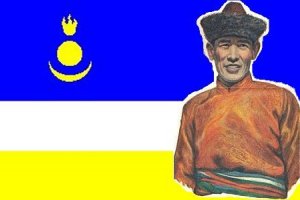BURYATIA
Geographical Features
The Buryat Republic is situated in the central part of Asia. Area: 351,300 km2. It borders Irkutsk and Chita Regions, Republic of Tuva and Mongolia and is adjacent to lake Baikal.
Population
The Buryat population is 450,000 people, more than half living within the Buryat Republic. A large percentage live in various regions of the Russian Federation and the CIS, as well as in parts of Mongolia and the Peoples Republic of China.
Ethnic Diversity
The Buryat people's ethnic origin is a mixture of Mongol, Turkic, Tungus, Samoyed and other related Ural-Altaic peoples. The ties between Mongol and Buryat tribes have been close throughout the centuries.
Languages
Buryat language.
Organisations
The All Buryat Association for the Development of Culture (ABADC) represents Buryatia in UNPO.
Economy
Natural resoucers: zinc, gold, bentonite, led, graphite, marble. 72% of the territory is covered
by forest. Industry: machine building, paper. Agriculture: vegetables, potatoes.
Brief History
- The name "Buryat" is mentioned for the first time in a Mongolian work (1240). Consolidation of tribes and groups took place in the conditions of the Russian state. In addition to genuine Buryat-Mongolian tribes (Bugalat, Khora, Ekhirit, Khongodor) which merged with the Buryats, the Buryats assimilated also other groups, for example Oirots, Khalkha Mongols, Tungus (Evenks) and others.
- In the 17th century Russia began to invade the region by taking over the most fertile lands and trade routes. The Buryat lands were annexed to the Russian state in 1689 and 1728, when the territories on both the sides of Lake Baykal were separated from Mongolia. From the middle of the 17th c. to the beginning of the 20th c., the Buryat population increased from 27,700 to 300,000. The historical roots of the Buryat culture are related to the Mongolian one. After Buryatia was incorporated into Russia, it was exposed to two cultures - Christian and Buddhist traditions. Buryats west of Lake Baikal (Irkutsk Buryats) are "russified", and they soon abandoned nomadism for agriculture, whereas the eastern (Transbaykal) Buryats are closer to the Mongols, may live in yurts and are mostly Buddhists.
- 1741 The Lamaist branch of Buddhism was recognized as one of the official religions in Russia, and the first Buryat datsan (Buddhist monastery) was built.
- The 2nd half of the 19th c. and the beginning of the 20th c. was a period of growth for the Buryat Buddhist church (48 datsans in Buryatia in 1914). Buddhism became an important factor in the cultural development of Buryatia. After the Revolution most of the lamas were loyal to the Soviet power.
- 1917 The Buryat National Committee was formed.
- 1923 The Buryat-Mongol Autonomous Soviet Socialist Republic was founded.
- 1925 A battle against religion and church in Buryatia started. Datsans were gradually closed down, and the activity of the church curtailed. Consequently, in the late 1930s, the Buddhist church ceased to exist and thousands of cultural treasures were destroyed.
- 1937 Buryatia was split into three parts: the Buryat-Mongol ASSR, the Irkutsk and the Chita provinces. In an effort to disperse Buryats, Stalin's government separated a number of counties (rayony) from Buryat-Mongol ASSR and formed Ust-Orda Buryat Autonomous Okrug and Aga Buryat Autonomous Okrug; at the same time some counties with Buryat population were left out. Fearing Buryat nationalism, Stalin had more than 10,000 Buryats killed.
- Attempts to revive the Buddhist Church started during World War II, officially it was re-established in 1946.
- 1958 The name "Mongol" was taken away from the name of the republic (Buryat ASSR).
- 1970s It was forbidden to teach the Buryat language in school.
- Genuine revival of Buddhism has taken place since the late 1980s as an important factor in the national consolidation and spiritual rebirth.
- BASSR declared its sovereignty in 1990, Republic of Buryatia since 1992, constitution of the Republic adopted by People's Hural in 1994, bilateral treaty with the Federation signed in 1995.
- 1996 The Russian Parliament passed a bill concerning legislation of the State National Policy of the Russian Federation.
Current situation
The Buryats are trying to regain their native culture and language, to solve ethnic problems and to establish contact with Buryats living outside their republic. A particular problem is that any vote for greater autonomy is blocked, due to the fact that Buryats have been reduced to a minority in their own land.
Sources: Norwegian Institute of International Affairs [NUPI] - Centre for Russian Studies
Unrepresented Nations and Peoples Organisation (UNPO)
Wikipedia: Buryatia
Lake Bajkal
Photos: Fedor Babanine, Nathan Lipsen, Dashi Choinkorlin Buddhist Institute
    
|











